Round The World and other travels
A frequent flyer's collection of trip diaries
This is: Round Ireland (2016-20)
Cork and Cobh
I woke up to a beautifully clear and sunny morning. At this time of year it was no surprise to see signs that it was also crisp and cold outside. It seemed as though nobody else was awake, both from the lack of any movement in the corridor and again at breakfast, which was uncannily quiet. Determined to make the most of the bright conditions, I set off around 9am, but only after removing a layer of ice from the car's windows and lights. Initially working my way around Cork's ring road and then approaching the city centre from the south, I found my intended car park at the first attempt - sometimes things just work! I quickly parked the car and got started on the first part of the day's sightseeing.
 |
 |
| Shopping opportunities in St Patrick's Street | |
Cork (Irish: Corcaigh), with a population of 125,000, is the second largest city in the republic and the third largest on the island of Ireland. Its history dates back to the 6th century AD and it has enjoyed city status since the 12th century. Cork has a number of nicknames, including 'the rebel city' and 'the real capital'. Exiting the modern shopping centre at Merchants Quay, I found myself on the heavily commercialised and pedestrian-friendly St Patrick's Street. After taking a few minutes to absorb my immediate surroundings and get my bearings, I made my way to the first of the city's attractions on my 'to do' list. It goes by a somewhat unexpected name:
English Market
Held in a group of beautiful Victorian buildings that were refurbished in the 1980s following a disastrous fire, the English Market has long since been popular with local people and has more recently also become a tourist attraction. It specialises in fresh meat and fish, supplying many of the city's top restaurants.
 |
 |
 |
 |
 |
 |
Elizabeth Fort
On leaving the market, I made my way towards the National Monument and the southern branch of the River Lee, catching sight of St Fin Barre's Cathedral in the distance. Before visiting the cathedral, however, I made a brief call at Elizabeth Fort, a five-point star fort dating from the 17th century and giving some good views of the city.
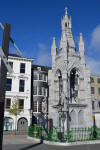 |
 |
LEFT: National Monument and the River Lee |
 |
 |
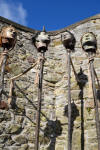 |
 |
RIGHT: Elizabeth Fort and its views across Cork |
 |
 |
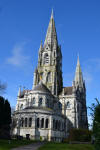 |
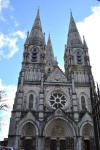 |
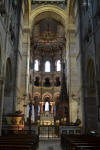 |
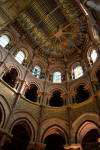 |
 |
 |
 |
 |
| ABOVE: The magnificent St Fin Barre's Cathedral | |||
A short walk then brought me to the magnificent Church of Ireland cathedral that I had been catching sight of since shortly after leaving the English Market. Dedicated to the city's patron saint, Finbarr of Cork, it was designed in Gothic Revival style by English architect William Burges. Construction was completed in 1879. The cathedral is one of three seats of the Anglican bishop of Cork, Cloyne and Ross. I thought the building looked superb both from the outside and within, and I enjoyed my short visit enormously.
But there was no time to linger, and soon I was back out in the morning sunshine and on a northwards course, crossing two branches of the River Lee and climbing up into the district of Shandon. My route took me via Crawford College and Cork Courthouse, across the 2004-built Shandon Bridge and close to the striking St Mary's Dominican Church, with its six Ionic columns guarding the bright red doors.
 |
 |
 |
 |
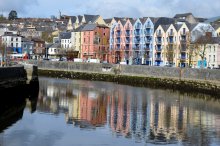 |
 |
 |
 |
 |
Shandon
After a short uphill stretch from the riverbank, I came to the Shandon Cultural Quarter, seeing first a rather odd, circular building rejoicing in the name Firkin Crane. It was the home of Cork City Ballet. Directly adjacent were the Cork Butter Museum, Shandon Craft Centre and St Anne's Church & Shandon Bells Tower. The latter had the triple distinction of being celebrated in song, offering visitors the opportunity to ring the bells, and having a particularly memorable nickname - The Four-Faced Liar! With the bells proving to be a bit too much of a popular choice, and the 132 steps a trifle off-putting, I decided to opt out and instead had a look around the butter museum. I had, after all, been familiar with the Irish Milk Board's Kerrygold brand since childhood.
| RIGHT and BELOW: An overview of the Shandon Cultural Quarter, with emphasis on the Cork Butter Museum |
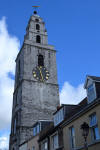 |
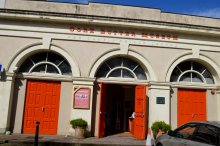 |
 |
 |
 |
 |
 |
Crawford Art Gallery
 |
 |
 |
| ABOVE: Crossing the Lee again, I found Cork Opera House | ||
Crossing the river again, I walked past Cork's modern-looking opera house, actually a general performance venue for a wide range of repertoire. My final major objective, Crawford Art Gallery, was just next door, which meant that I had done well in keeping to schedule. The gallery is home to a popular collection of classical and contemporary art, housed in the former Cork Customs House.
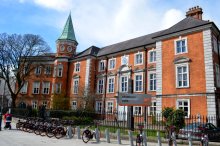 |
 |
 |
 |
 |
 |
 |
 |
 |
After a short break for lunch at Starbucks, I completed this short visit to the Republic of Ireland's second city by crossing the southern branch of the Lee one more time (on Parliament Bridge on this occasion), then walking along to City Hall and finally back to Merchants Quay.
 |
 |
 |
 |
 |
 |
Onwards to Passage West and Cobh
 |
 |
 |
| ABOVE: Taking the Passage West ferry, en route to Cobh | ||
I thought I'd forgotten where I'd left my rental car in the large, multi-storey parking facility at Merchants Quay. Something made me press '2' when I got into the lift - I still don't know what - and I reached my car within seconds of stepping out onto that level. I drove to Passage West for my second five-minute car ferry transit in a couple of days. Thereafter, it was barely a ten-minute drive to my next destination.
Cobh (pronounced 'Cove') is a small seaside town on the south coast of the Great Island in Cork Harbour. In 1849 it was renamed Queenstown to mark a visit by Queen Victoria, but it reverted to its traditional name in 1920. As Queenstown, it was the final port of call of RMS Titanic on 11 April 1912, where the ill-fated liner uplifted its last 123 passengers. I arrived in the town during a violent hail shower - quite a contrast with the glorious weather experienced in Cork only an hour or two earlier. I took a few photos of the colourful little town, built into a steep hillside with the gigantic Gothic Revival bulk of St Colman's RC Cathedral towering over everything from its elevated location. When a second heavy hail shower threatened to spoil things, I retreated into the little seafront museum marking Titanic's brief visit over 100 years previously.
 |
 |
 |
 |
 |
 |
Finally, I drove the car up to St Colman's for a closer look at this huge structure, both outrageous and magnificent in the sheer scale of its conception. It was terribly dark inside, which made taking photos somewhat challenging - but I'm sure the prevailing weather conditions didn't help in that respect. I thought the interior was mostly tasteful, but I did spot one or two statues that seemed to be of a poorer standard and which jarred against the overall sense of quality.
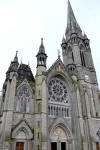 |
 |
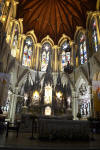 |
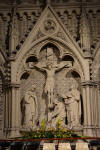 |
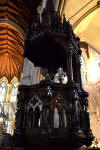 |
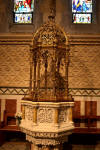 |
 |
I then had an easy drive back to base on this
low-mileage day, arriving around 4:30 in the afternoon. After a
spell of well deserved relaxation in my room, I had dinner in the
hotel bar. The food was good and my one glass of wine tasted fine,
but the atmosphere was dire, thanks to a large group of dressed-up
oiks. Their foul-mouthed, drunken yelling in front of the young
children in their own group was a revolting spectacle.
![]() I couldn't
wait to get out of there, wishing that I had instead opted for room
service. What a shame to end a great day with such a depressing and
annoying experience!
I couldn't
wait to get out of there, wishing that I had instead opted for room
service. What a shame to end a great day with such a depressing and
annoying experience!